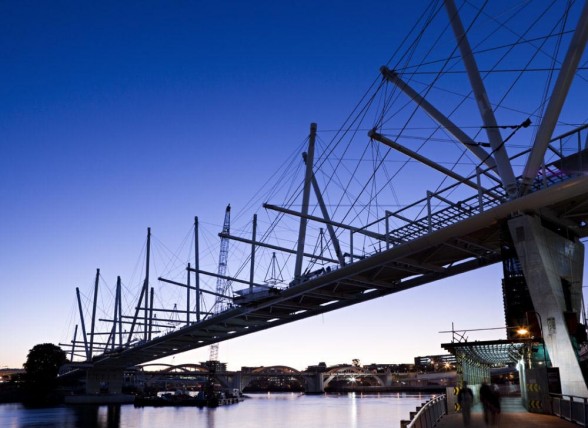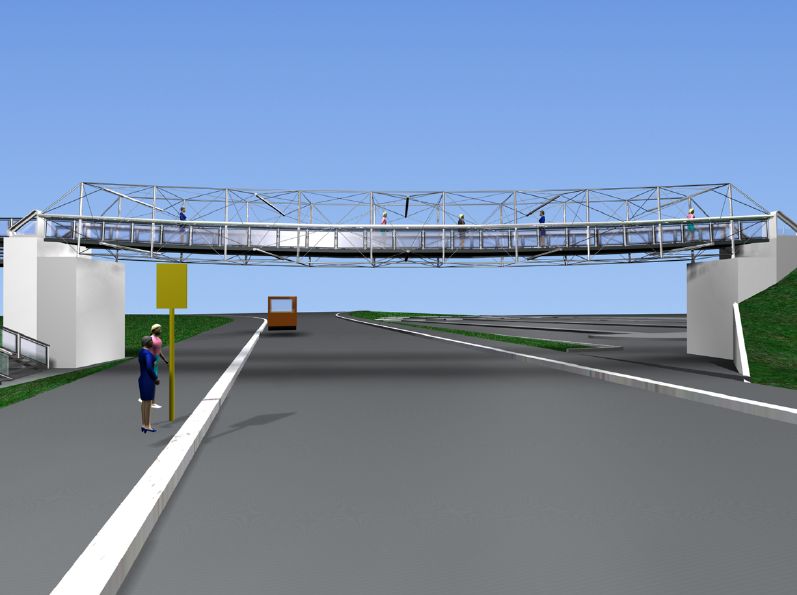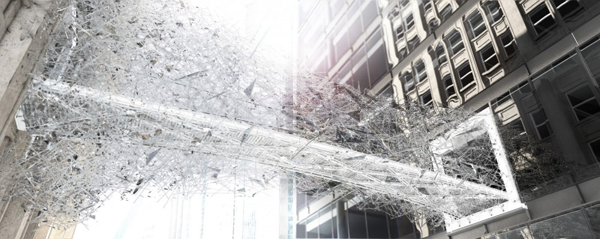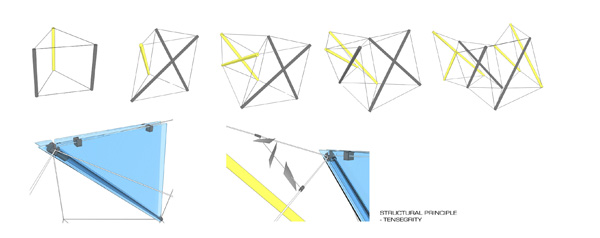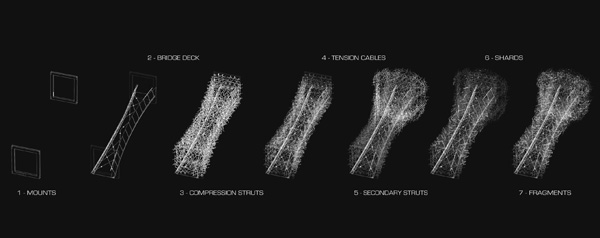Bridge
A bridge is a structure built to span a valley, road, body of water, or other physical obstacle such as a canyon, for the purpose of providing passage over the obstacle. Read here about bridges built according to tensegrity principles, or to view images of such bridges.
A bridge is also a theoretical concept in graph mathematics. See Graph.
Bridge Concepts and the Role of Tensegrity
Tensegrity plays a role in bridge design and materials.
Bridge Design
Bridge design proceeds in accordance with local standards. These provide specific metrics for load and resistance factors that are then simulated in computer models and tested both in simulation and after deployment. For a vehicle bridge, at the heart of the load specification is the design vehicle. The current Western standard is a 1940's era truck, though truck lengths, weights and traffic counts have changed significantly since then. This standard vehicle is attributed with "weight in motion" behavior that must be accommodated.
Naturally, the market for tensegrity bridge software modelling tools lags behind the standard bridge engineering tool market. See software. Due to the complexities of planning for vehicles, most tensegrity bridge designs are footbridges. As the Pontist wrote, "tensegrity still throws down a huge challenge to the structural designer - conventional habits of design, both in terms of structural analysis and visual order, simply aren't sufficient."
Bridge Materials
Bridges today are constructed of concrete, steel, timber and fiber-reinforced plastics, and these materials continue to be enhanced. Current innovation is in the arena of high-strength and high-performance steel, high-performance concrete, and the blending of fiber-reinforced plastic and timber. Most, if not all, of this innovation focuses on traditional construction notions that blend tension and compression in modular construction units, and incorporate the Earth as an integral structural feature, with ground-afixed stays and gravity contributing to the structural integrity of the bridge.
Tensegrity specialists divide materials more strictly into tension-bearing and compression-bearing types, and as such, are not currently driving bridge material development. For tension materials, tensegrity bridges use the same steel cables deployed by suspension bridge and cable-stayed bridges. Their deployments have the same limitations, such as the need for regular painting to prevent corrosion by weather and de-icing salts. For compression materials, tensegrity bridges use traditional bridge truss or girder material, though often in the cylindrical form of pipes.
Tensairity actively markets their pneumatic beams for bridge projects, but none have been deployed to date.
Advantages and Disadvantages of Tensegrity Structure in Bridge Engineering
Tensegrity structures promise to be highly efficient in the ratio of material to both performance and maintenance. Tensegrity is also ideal to support the current trend towards smart roadbeds, as its conceptual divide between tension and compression simplifies the collection of field data. These promises have not yet been borne out in practice, however. Proponents of tensegrity attribute this to the immaturity of the tensegrity engineering craft. They cite the Eifell Tower and the Brooklyn Bridge as spectacular early deployments of new technologies--iron trusswork and suspension bridge, respectively--that deliberately over engineered and added redundancies that later structures eliminated. According to this argument, early tensegrity bridges are probably over-designed.
Critics of tensegrity are skeptical that tensegrity structures will prove to be a more efficient bridge morphology. One important aspect of successful bridge design is its ability to be widened in response to increased traffic. Classic tensegrity structures are holistically conceived and are not amenable to widening along one axis.
See also advantages of tensegrity.
Gallery Of Bridges Built According To Tensegrity Principles
A gallery of bridges that employ tensegrity principles, deployed or proposed.
Kurilpa Bridge
Kurilpa Bridge is a footbridge with tensegrity-like structural elements deployed in Brisbane, Australia by Cox Rayner. See Kurilpa Bridge.
Footbridge Proposal by Tor Vergata University
Andrea Micheletti is head of the Research Group on Tensegrity Systems, University of Rome Vergata] . His group planned a 32m spanning footbridge and announced it at a Footbridge 2005 conference (see [http://users.wpi.edu/~bservat/micheletti10.pdf%7C"The tensegrity footbridge at TorVergata").
The Happy Pontist describes the bridge here, http://happypontist.blogspot.com/2009/06/tensegrity-bridges-2-passerella.html. Its tensegrity structure is based on a row of five "expanded octahedra", each of which is a classic, prestressed tensegrity. However, octahedra join in such a way that two struts share a common node, not a pure tensegrity morphology. The Pontist notes that such compromises prove that pure tensegrity is not suited to bridge-making. Micheletti shares more details of the design in an Italian PowerPoint, passerella pedonale tensintegra per il campus di TorVergata (Powerpoint).
The Pontist also notes that the bridge is not much more efficient, in that it weighs "about the same as a conventional footbridge design for the same span."
Footbridge Proposals by Wilkinson Eyre
Wilkinson Eyre and Arup proposed a 35m footbridge spanning the Washington DC National Museum's Great Hall] in order to connect galleries. The design was exhibited at the Architectural Biennale in 2004. The bridge is to be an active exhibit in and of itself, with glass tube struts and dynamic events that react to people crossing the bridge.
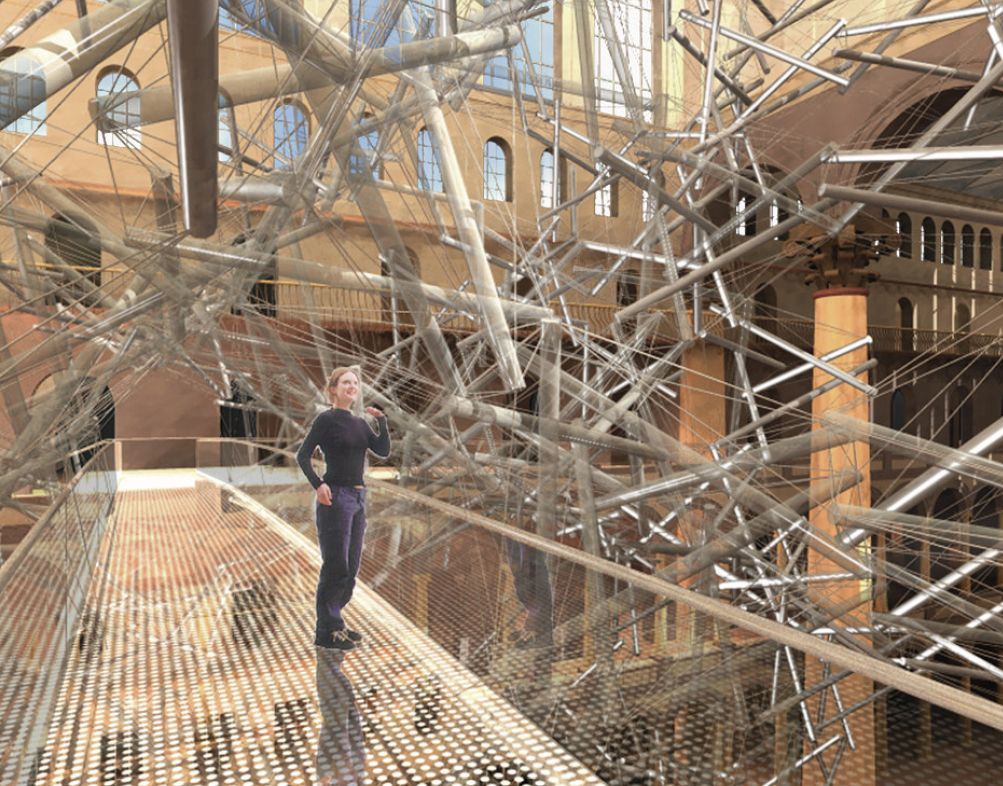 Image width="498" height="391"
caption="National Building Museum Footbridge Proposal, Washington, DC by Wilkinson Eyre"
Image width="498" height="391"
caption="National Building Museum Footbridge Proposal, Washington, DC by Wilkinson Eyre"
Eyre also proposed a footbridge for the Apraksin Dvor area of St Petersburg, The bridge would be suspended by an associated tensegrity "cloud." The Happy Pontist uncovered the photo below, but no further details. See [1]]
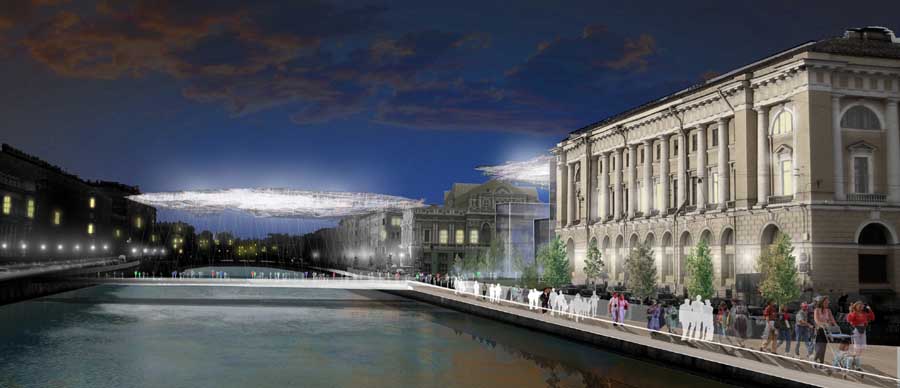 height="193"
caption="St Petersburg Footbridge Proposal, St. Petersburg, Russia by Wilkinson Eyre"
height="193"
caption="St Petersburg Footbridge Proposal, St. Petersburg, Russia by Wilkinson Eyre"
Splash Bridge Proposal by Cullum
“Splash” was designed by Joel Cullum and was runner-up in judges’ voting in the June 2012 DesignByMany Building to Building Bridge Challenge. The contest's aim was to explore the creative ways of connecting two neighboring buildings, while trying to implement the principles of modularity, adaptability to various conditions, quick assemblage, etc. Cullum desribed his proposal as “a bridge caught within a single frame of explosive velocity. The tensional lattice work is integral to the structure of the suspended deck, whilst providing the chaotic, yet ordered network of cables and compression rods working to freeze the fragments in mid air.”
In this bridge, like in Kurilpa Bridge, tensegrity is incorporated as a decorative element and is not part of the structure's essential cohesion. one may also say that the tensegrity elements are framed by conventional, non-tensegrity, bridge structure.
Site: [2]]
Bankside Bridge Proposal
According to the Happy Pontist, Mott MacDonald proposed a bridge crossing the Thames (London, UK) as part of the Bridge] design competition.
File:Bridge Bankside night.jpg
Image width="459" height="142"
caption="Bankside Bridge Proposal, London, UK by Mott MacDonald"
File:Bridge Bankside Diagram.jpg Image width="480" height="80" caption="Bankside Bridge Proposal, London, UK by Mott MacDonald"
Link: [3]]
Deployable Bridge Thesis Proposal
Barbarigos] proposed a deployable bridge as part of his master's thesis. The span incorporates dynamic capabilities in the form of telescoping struts and pulley-adjustable tension.
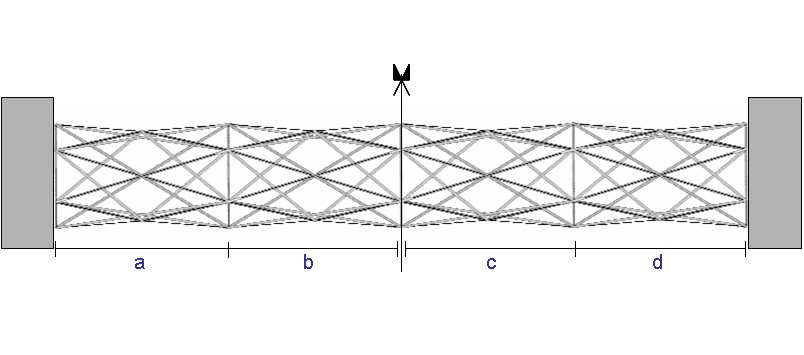 Image width="399" height="175"
caption="Deployable Bridge Thesis Proposal by Landolf-Rhode"
Image width="399" height="175"
caption="Deployable Bridge Thesis Proposal by Landolf-Rhode"
 Image width="557" height="181"
caption="Deployable Bridge Thesis Proposal by Landolf-Rhode"
Image width="557" height="181"
caption="Deployable Bridge Thesis Proposal by Landolf-Rhode"
Bamboo Footbridge Proposal
Michael McDonough proposed a 133m cable-truss bridge that incorporates some concepts from tensegrity, with bamboo struts.
Links: McDonouhg's proposal, bridge] Happy Pontist review and critique, [4]]
 Image width="540" height="154"
caption="Bamboo Bridge Proposal by McDonough"
Image width="540" height="154"
caption="Bamboo Bridge Proposal by McDonough"
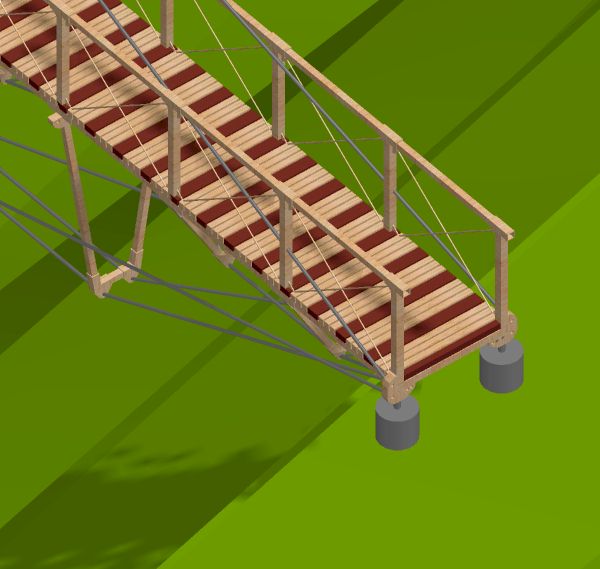 Image width="540" height="512"
caption="Bamboo Bridge Proposal by McDonough"
Image width="540" height="512"
caption="Bamboo Bridge Proposal by McDonough"
Tube Bridge Proposal
Andreas Kirchsteiger of the University of Technology] proposed a tubular bridge composed of connected by woven fabric]. While the tubes are tensegrity structures, the attachment of the support struts to the rings is more conventional. The jury report read, "The combination of cable-tensioned steel-section compression rings, supported and stabilised by tension-stressed (Kevlar-reinforced) membrane strips running diagonally in two furrows along the outside surface is impressive and logical. The membrane strips, however, are not only a clear constructional component but serve as an “open” roof for the bridge walkway without turning it into a closed tube for the user."
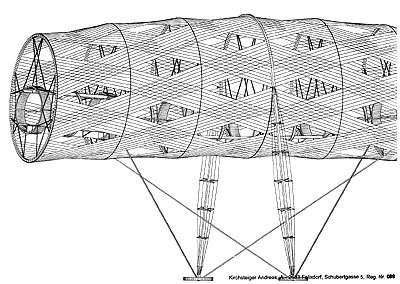 caption="Tube Bridge Proposal by Kirchsteiger"
caption="Tube Bridge Proposal by Kirchsteiger"
Link: [5]]
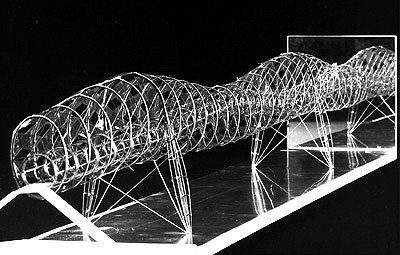 caption="Tube Bridge Proposal by Kirchsteiger"
caption="Tube Bridge Proposal by Kirchsteiger"
Simplex Module Footbridge Proposal
Gómez Jáuregui's thesis features a proposal for a Simplex Module Footbridge, a lightweight modular design ideal for short spans.
Links:
[6]] thesis was published as a book, [7]]. Purchase link: [8]]
File:Bridge Footbdridge from Simplex modules Valentín Gómez Jáuregui.jpg Image width="346" height="226" caption="Simplex Module Footbridge Proposal by Jáuregui"
Links and References
The Happy Pontist reports regularly on tensegrity structures, see [9]]
